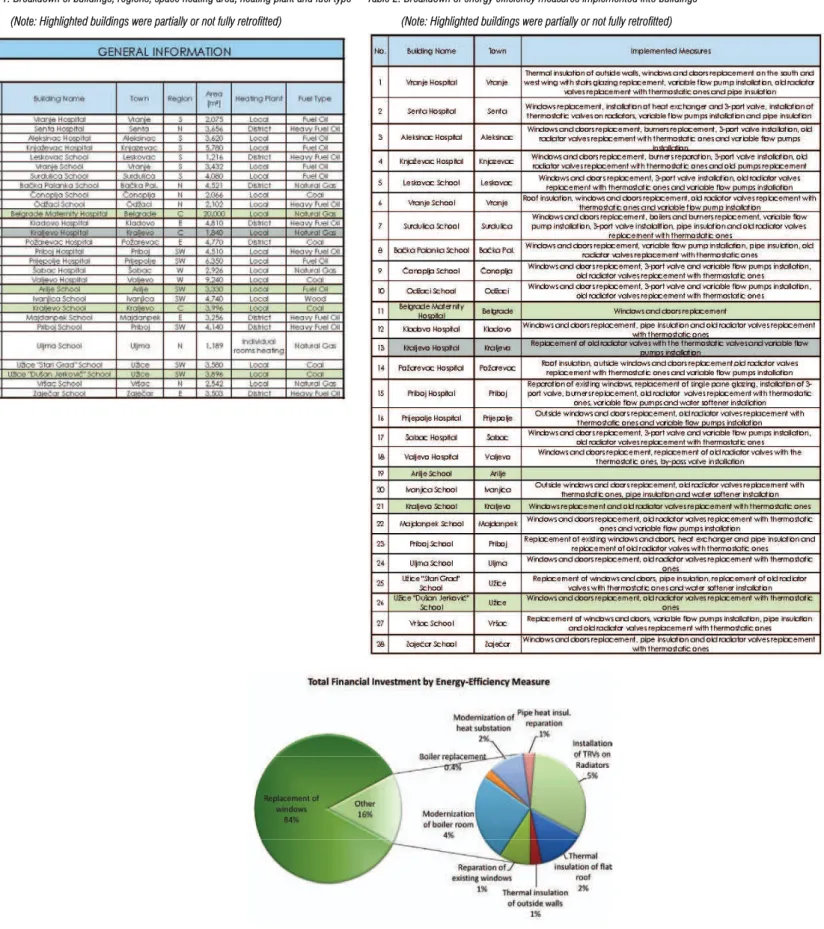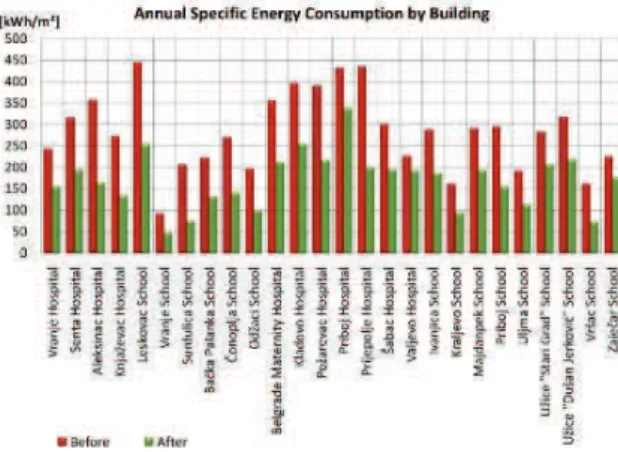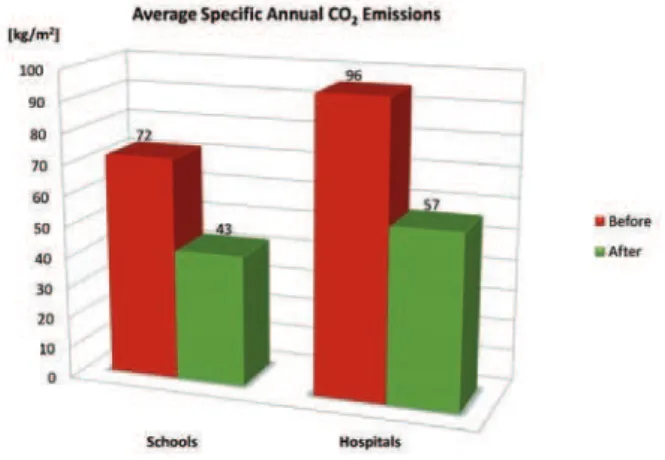EVALUATION OF ENERGY EFFICIENCY MEASURES
APPLIED IN PUBLIC BUILDINGS
(SCHOOLS & HOSPITALS) IN SERBIA
Siniša Stankovi
ć
1, BDSP Partnership Ltd Summit House, London, UK
Neil Campbell
, BDSP Partnership Ltd Summit House, London, UKDuško Maksimovi
ć
, BDSP (YU) d.o.o., Belgrade, SerbiaTanja Cvjetkovi
ć
, BDSP (YU) d.o.o., Belgrade, SerbiaThe Serbian Energy Efficiency Project 1 (SEEP1 – Design and Supervision Support for Implementation of the Energy Efficiency Improvements in Public Buildings in Serbia), funded by a credit from The World Bank, has involved the energy efficient refurbishment of 28 public buildings in Serbia (12 hospitals and 16 schools). The major goal of the project has been implementation of the energy efficiency improvements in public buildings in Serbia and the verification of the energy and cost savings as well as CO2 emission reductions achieved through implementation of the energy efficiency measures. Significant
energy consumption savings have been achieved for all refurbished buildings with annual savings in the range of 15% to 63% and an average of 40% over entire project. Associated annual CO2 emission reductions vary between 15% to 64% with an
average of 42%. The average specific space heating annual energy consumption for the hospitals monitored was ~339 kWh/m2
and has been reduced down to ~205 kWh/m2 after refurbishment. The average specific space heating annual energy
consumption for the schools monitored was ~243 kWh/m2 and has been reduced down to ~144 kWh/m2 after refurbishment.
The simple payback period (SPP) on investment across all buildings was found to be about 7.5 years. For hospitals, due to their 24/7 operation, the average SPP is 5.3 years and for schools is 12.8 years.
Key words: energy efficiency measures applications, buildings, energy consumption savings, CO2 emission reduction, energy
performance "before" and "after" monitoring and verification, simple payback period.
INTRODUCTION
1
Many schools and hospitals in Serbia are large energy consumers due to poor thermal characteristics of building fabric and inefficient heating equipment. For existing buildings, a set of energy efficiency measures was implemented to create environmentally friendly and energy conserving buildings while maintaining indoor thermal comfort. A joint venture (JV) between BDSP Partnership (London, UK), BDSP YU (Belgrade, Serbia) and Energoprojekt-Entel (Belgrade, Serbia) has been appointed by Serbian Energy Efficiency Agency (SEEA) to carry out energy efficiency
127 Sale Place, London W2 1YR, UK
sinisa.stankovic@bdsp.com
improvements in public buildings across Serbia. This project lasted from 2005 to 2009. The objectives of this four-years project entitled Serbian Energy Efficiency Project 1 (SEEP 1) are listed below:
•Implementing energy saving measures on building envelope, heating system and interior lighting
•Increase in end-user satisfaction about energy efficiency and indoor comfort
•Awareness raising of the end users about energy efficiency and rational use of energy
This paper summarizes outcomes of SEEP 1 through energy and carbon savings as well as investment payback period. The results are presented in the following sections.
METHODOLOGY
Overview
A total of 12 hospitals and 16 schools in various regions of Serbia have participated in the project. Breakdown of participating public buildings with respect to region, space heated area, heating plant and fuel type is presented in
Table 1. All calculations are based on floor heated area. For all refurbished buildings, a fuel source remained the same as before retrofit except for Maternity Hospital in Belgrade. The heavy fuel oil fired boiler has been substituted with that of natural gas. The boiler room refurbishment has not been the part of SEEP 1.
implemented and scheduled to be completed during summer 2009. These buildings include Belgrade Maternity Hospital, ‘Dušan Jerković’ school in Užice and schools in Arilje and Kraljevo. However, some measures have been applied and post retrofit monitored data have been collected and presented in this report. No construction work has undertaken at school in Arilje; and thus, excluded from analysis. Finally, hospital in Kraljevo has been excluded from investigation due to time schedule conflict (Table 1).
Energy Efficiency Measures
Applied energy efficient measures have been focused on improving thermal performance of building’s fabric and heating system by installing air tighter windows and doors with lower U values, improving roofs and external walls insulation as well as installing more efficient mechanical systems and controls. It should be noted that installation of efficient lighting system has been done not to reduce overall energy consumption but to improve occupants’ comfort via higher illuminance levels. Extensive list of selected energy efficiency measures per building is presented in Table 2.
These measures have been used as an input to a 3D thermal building energy simulation model and evaluated based on carbon-energy savings and SPP per building. Assessment has been done by JV team and sent to SEEA for approval. The optimum set of measures has not only been selected based on the shortest payback period and lowest carbon emissions but also on suggestions of building’s end-users. These measures included works with minimal influence on undisturbed operation of a building, priority works e.g. windows replacement over that of boiler replacement or effective low time consuming retrofits to be finished before beginning of the heating season in order to start monitoring process. Simulations (‘Predicted performance’) and measurements (‘Measured performance’) have been done for pre and post retrofit (‘Before’ and ‘After’) stage of a building. The results have been analyzed on comparative basis (Table 2).
Figure 1 illustrates breakdown of total
investment per implemented energy efficiency measure. Installation of new windows has been extensively used across virtually all buildings due to poor thermal performance of
existing windows and cold air infiltration causing draughts near fenestration.
While investment costs of window replacement accounted for 84% of the total project budget, boiler replacement investment costs accounted for 0.4%.
Building Energy Modelling
Transient building energy simulation software –TAS has been used for building thermal analysis. A 3D geometry model and thermal properties of the building envelope have been defined along with thermal zones where occupancy schedule is considered to take into account heat gains from occupants. Weather files for selected locations have been used as input to annual simulation with time step of an hour.
Annual energy consumption, properly adjusted for the purpose, has been used for carbon emissions and SPP calculations. System efficiency and heat distribution losses have been also accounted in calculations.
It should be noted that SPP has been calculated as ratio between total investment cost of implemented measure and annual cost saving through reduced fuel consumption.
Experimental Setup
Energy consumption has been measured by energy flow meters installed in heating substations as depicted in Figure 3. Monitoring process has been conducted before and after retrofits for entire heating season (referred as annual in the paper) i.e. from November to March pending on weather conditions. As depicted in Figure 4, indoor air temperature and humidity in a zone have been measured by a sensor. Measurements have been used to determine annual heating energy consumption, whether indoor set point conditions have been achieved or additional adjustments have been required e.g. regulation of TRV valves. These parameters have been measured before and after implementation of energy saving measures in buildings. Three zones per building have been selected for measurements. Sensors have been decommissioned and reused in other buildings, afterwards. Thus, two months of recorded data during heating season have been obtained. Measured energy consumption for these corresponding months have been extrapolated over the whole heating season and used for comparison analysis.
RESULTS AND DISCUSSION
Energy Savings
Comparison of averaged specific energy consumption measured before and after retrofit is depicted in Figure 5. While average measured energy consumption for post retrofitted hospitals and schools is cca. 205 kWh/m2
and 144 kWh/m2
respectively, monitored pre retrofit building’s energy consumption is found to be 339 kWh/m2
and 243 kWh/m2
. Energy consumption reduction of around 40% has been achieved by implementing selected energy efficiency measures. Higher energy consumption of hospitals compared to that of schools was due to higher indoor set point temperatures and around the clock business hours. Detail breakdown of energy conserving measures applied per building along with energy consumed before and after refurbishments is presented in Appendix A.
Figure 6 summarizes post retrofit total
measured energy consumption over a heating season for all buildings and achieved savings. Amount of saved energy could cover heating needs of 15 refurbished schools for a 2 years period.
Figure 7 presents comparison of measured unit energy consumption before and after retrofit per building. While significant energy conservation in range of 45%-55% is achieved at hospitals in Aleksinac, Požarevac, Knjaževac, Prijepolje, the lowest energy savings by 17% is achieved in Valjevo hospital. Similar patterns are observed in schools. The school in Surdulica experienced the highest energy savings of cca.60%. Buildings located in cold mountainous regions of South-West Serbia have higher energy consumption than that in other parts of the country as can be concluded from Figures 8 and 9. Figure 10 suggests that simulated and measured energy savings after implementation of energy efficiency measures are in excellent correlation.
Towards Serbian Energy Benchmarks
energy benchmarks as depicted in Figure 11. These measures could also be used as a part of operational energy ratings system that has been introduced to implement Energy Performance of Buildings Directive. They represent typical practice figures against which energy bills/metered data can be compared in order to assess performance on an A-G scale. It should be noted that UK and German figures are adjusted to account energy consumption for space heating only excluding electricity and heating for other purposes.
Carbon Emission Savings
Difference in average annual specific CO2
emissions pre and post retrofit follow the same pattern as that of energy consumption. Figure 12 indicates an average of 42% of carbon emission reductions for both schools and hospitals. Carbon emission savings are higher in hospitals than those in schools due to higher energy consumption savings.
Significant carbon emission reductions are achieved after retrofit and depicted in Figure 13. Amount of 4223t CO2 is saved over a
heating season for all buildings.
Figure 14 presents comparison of specific carbon emissions before and after retrofit per building. The savings are in the range of 20% to 50%. Carbon emissions are influenced by energy consumption and fuel type source. The highest CO2 emission reductions from cca.175
kg/m2
down to 100 kg/m2
are achieved at Požarevac hospital. The hospital is heated by coal which has the highest CO2 emission factor
and has one of the highest energy consumption. Enhanced levels of carbon emissions are achieved at Belgrade Maternity Hospital due to substituting heavy fuel oil with natural gas fired boiler. For buildings with app. equal energy consumption, natural gas fired individual boilers yield lower CO2 emissions
then that of coal fired individual boilers due to lower carbon emission factors. In contrast, higher energy demanding buildings utilizing fuel oil/heavy fuel oil emit the app. the same amount of CO2 as lower energy consuming
building using coal as a heat source. Simulated and ‘measured’ carbon emissions savings are in excellent correlation as depicted in Figure 15.
Investment and Payback Period Analysis
Payback period for considered public buildings is depicted in Figure 16. While average SPP in
hospitals is 5.3 years, SPP in schools is estimated to be cca. 12.8. On average, total investment for the entire project is to be paid off in 7.5 years.
Figure 17 indicates that unit investment in the building envelope upgrade is significantly higher than that of thermally improved mechanical system. The unit investment in building fabric improvements is the highest at Majdanpek school reaching cca.70 €/m2 as
opposed to that of Zajecar school with cca. 25 €/m2. The most expensive retrofit of the heating system is found to be at Surdulica school and Priboj hospital. The average unit investment for hospitals is
cca. 40 €/m2 compared to that of schools with
cca. 50 €/m2.
Figure 18 depicts average unit window investment and difference in U value between replaced and new windows. The PVC windows have the best cost and U value improvement ratio.
CONCLUSIONS
Energy conserving measures implemented on building envelope and heating system in 28 retrofitted public buildings in Serbia have been analyzed and presented. Replacement of existing windows has been the most frequent measure applied into buildings. Significant energy and carbon emission savings of cca.
40% have been achieved. While measured average unit energy consumption for hospitals and schools has been found to be cca. 205 kWh/m2 and 144 kWh/m2 respectively“after”
refurbishment, monitored energy consumption has been found to be 339 kWh/m2 and 243
kWh/m2 respectively “before” refurbishment.
These results might be used to give an idication of energy performance and typical space heating energy benchmarks in Serbian schools and hospitals but further investigation is recommended. Carbon emissions are influenced by energy consumption and fuel type. The simple payback period on investment is found to be 5.3/12.8 years for hospitals/schools, respectively. For the entire project, the average payback period has been found to be 7.5 years. In most cases, depending on the financing options, we expect this SPP to be considered favourable.
Acknowledgement
Financial support for this work has been provided by The World Bank via Serbian Government.
Nomenclature
SEEA Serbian Energy Efficiency Agency SEEP Serbian Energy Efficiency Project
SPP Simple Payback Period
TRV Thermostatic radiator valves
U Overall heat transfer coefficient
(W/m2 K)
References
The Chartered Institution of Building Services Engineers (CIBSE), 2008, Energy Benchmarks TM46, UK
Table 1: Breakdown of buildings, regions, space heating area, heating plant and fuel type
(Note: Highlighted buildings were partially or not fully retrofitted)
Table 2: Breakdown of energy efficiency measures implemented into buildings
(Note: Highlighted buildings were partially or not fully retrofitted)
Figure 2: 3D thermal building model of Vranje Hospital
Figure 3: Photo of variable speed pump and heat flow meter in heating substation
Figure 5: Comparison of average annual unit energy consumption before and after retrofit Figure 6: Total measured energy consumption and achieved savings after retrofit
Figure 7: Comparison of measured unit energy consumption before and after retrofit breakdown Figure 8: Average unit energy consumption in hospitals per region breakdown
(Note: C-Central, E-East, N-North, S-South, SW-South-West, W-West)
Figure 9: Average unit energy consumption in schools per region breakdown Figure 10: Comparison of measured and simulated energy consumption savings breakdown
Figure 12: Comparison of average annual unit carbon emissions before and after retrofit
Figure 13: Total carbon emission and achieved savings after retrofit Figure 14: Comparison of unit carbon emissions before and after retrofit breakdown
Figure 15: Comparison of measured and simulated carbon emission savings breakdown Figure 16: Simple payback period breakdown Figure 11: Comparison of building energy benchmarks in Serbia, UK and Germany
Figure 17: Unit investment of energy efficiency measures breakdown Figure 18: Average unit window investment and U value breakdown
APPENDIX A


